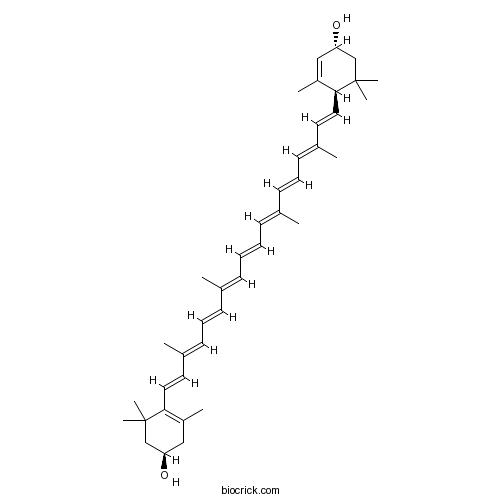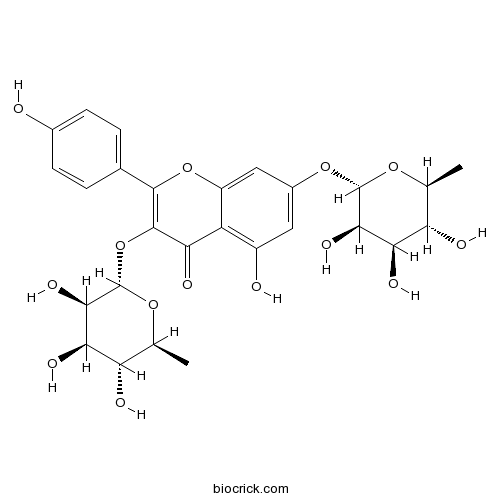Tagetes erecta
Tagetes erecta
1. The products in our compound library are selected from thousands of unique natural products; 2. It has the characteristics of diverse structure, diverse sources and wide coverage of activities; 3. Provide information on the activity of products from major journals, patents and research reports around the world, providing theoretical direction and research basis for further research and screening; 4. Free combination according to the type, source, target and disease of natural product; 5. The compound powder is placed in a covered tube and then discharged into a 10 x 10 cryostat; 6. Transport in ice pack or dry ice pack. Please store it at -20 °C as soon as possible after receiving the product, and use it as soon as possible after opening.
Natural products/compounds from Tagetes erecta
- Cat.No. Product Name CAS Number COA
-
BCN6151
Lutein127-40-2
Instructions

-
BCN5572
Kaempferitrin482-38-2
Instructions

Transformation of naturally occurring (3R,3'R,6'R)-lutein and its fatty acid esters to (3 R)-β-cryptoxanthin and (3R,6'R)-α-cryptoxanthin.[Pubmed: 29990480]
The objective of this study was to develop straightforward processes that could be applied to the large-scale production of β-cryptoxanthin in an attempt to facilitate investigation of its biological activity. An oleoresin obtained from crude extracts of marigold flowers (Tagetes erecta) with approximately 24% total lutein fatty acid ester content was directly used as starting material for partial synthesis of (3 R)-β-cryptoxanthin under mild reaction conditions at ambient temperature. Therefore, acid-catalyzed deoxygenation of lutein esters from marigold oleoresin followed by hydrogenation in the presence of catalytic amount of platinum (Pt) supported on alumina (5%) at ambient temperature gave a mixture of (3 R)-β-cryptoxanthin fatty acid esters (major) and (3 R,6'R)-α-cryptoxanthin fatty acid esters (minor). Saponification and Z-to-E isomerization of the product followed by crystallization gave a mixture of (3 R)-β-cryptoxanthin as the major product. Similarly, acid-catalyzed hydrogenation of unesterified (3 R,3'R,6'R)-lutein with Pt/alumina in ethyl acetate gave a mixture of (3 R,6'R)-α-cryptoxanthin acetate (minor) in a one-pot reaction. Alkaline hydrolysis and Z-to-E isomerization of the mixture followed by crystallization provided (3 R)-β-cryptoxanthin.
Spasmolytic effect of aqueous extract of Tagetes erecta L. flowers is mediated through calcium channel blockade on the guinea-pig ileum.[Pubmed: 29864942]
None
The transcriptome analyses of Tagetes erecta provides novel insights into secondary metabolite biosynthesis during flower development.[Pubmed: 29574190]
Genomic and transcriptomic sequences of Tagetes erecta are very limited in public databases, despite its nutritional and economical value. In this study, nine cDNA libraries were constructed from leaves, immature and mature flowers and sequenced using Illumina Hiseq 2000. Over 45.66 Gb nucleotides were generated and a total of 72,499 unigenes were assembled, 34,892 (48.13%) of which were annotated in NR, Swiss-prot, COG, GO, KOG, KEGG and Pfam. 11,721 differentially expressed genes were identified in leaves, immature flowers and mature flowers. The differentially expressed genes between immature flowers and mature flowers were mainly involved in photosynthesis and secondary metabolite biosynthesis. Additionally, the catalysis-related unigenes and their expression involved in carotenoids biosynthesis were determined. Using our newly identified reference genes as internal control, the expression profiles of carotenoids biosynthetic genes were verified by real-time qRT-PCR, and four of the unigenes were cloned for full length sequences confirmation. Furthermore, gene expansions occurred among the catalytic gene families in carotenoids biosynthesis pathway, which might explain the high pigment content in T. erecta.
Effects of living hyperaccumulator plants and their straws on the growth and cadmium accumulation of Cyphomandra betacea seedlings.[Pubmed: 29510305]
To determine whether the living hyperaccumulator plants and their straws have the same effects on the growth and heavy metal accumulation of common plants, two pot experiments (intercropping experiment and straw mulch experiment) were conducted to study the effects of living hyperaccumulator plants (Solanum photeinocarpum, Tagetes erecta, Galinsoga parviflora and Bidens pilosa) and their straws on the growth and cadmium (Cd) accumulation of common plant Cyphomandra betacea seedlings. Intercropping with T. erecta or B. pilosa promoted the growth of C. betacea seedlings compared with the monoculture, while intercropping with S. photeinocarpum or G. parviflora inhibited that. Intercropping with S. photeinocarpum decreased the Cd contents in the roots and shoots of C. betacea seedlings compared with the monoculture, but intercropping with the other plants did not. In the straw mulch experiment, the straw of S. photeinocarpum or T. erecta promoted the growth of C. betacea seedlings compared with the control, while the straw of G. parviflora or B. pilosa did not. The straw of S. photeinocarpum or T. erecta decreased the Cd contents in the shoots of C. betacea seedlings, and the straw of G. parviflora or B. pilosa increased the shoot Cd contents. Thus, intercropping with S. photeinocarpum and applying S. photeinocarpum or T. erecta straw can reduce the Cd uptake of C. betacea.
Stability lies in flowers: Plant diversification mediating shifts in arthropod food webs.[Pubmed: 29451903]
Arthropod community composition in agricultural landscapes is dependent on habitat characteristics, such as plant composition, landscape homogeneity and the presence of key resources, which are usually absent in monocultures. Manipulating agroecosystems through the insertion of in-field floral resources is a useful technique to reduce the deleterious effects of habitat simplification. Food web analysis can clarify how the community reacts to the presence of floral resources which favour ecosystem services such as biological control of pest species. Here, we reported quantitative and qualitative alterations in arthropod food web complexity due to the presence of floral resources from the Mexican marigold (Tagetes erecta L.) in a field scale lettuce community network. The presence of marigold flowers in the field successfully increased richness, body size, and the numerical and biomass abundance of natural enemies in the lettuce arthropod community, which affected the number of links, vulnerability, generality, omnivory rate and food chain length in the community, which are key factors for the stability of relationships between species. Our results reinforce the notion that diversification through insertion of floral resources may assist in preventing pest outbreaks in agroecosystems. This community approach to arthropod interactions in agricultural landscapes can be used in the future to predict the effect of different management practices in the food web to contribute with a more sustainable management of arthropod pest species.
Evaluation of certain food additives.[Pubmed: 29144073]
This report represents the conclusions of a Joint FAO/WHO Expert Committee convened to evaluate the safety of various food additives, including flavouring agents, with a view to concluding as to safety concerns and to preparing specifications for identity and purity. The first part of the report contains a general discussion of the principles governing the toxicological evaluation of and assessment of dietary exposure to food additives, including flavouring agents. A summary follows of the Committee’s evaluations of technical, toxicological and dietary exposure data for 10 food additives (Allura Red AC; carob bean gum; lutein esters from Tagetes erecta; octenyl succinic acid (OSA)– modified gum arabic; pectin; Quinoline Yellow; rosemary extract; steviol glycosides; tartrazine; and xanthan gum) and five groups of flavouring agents (alicyclic, alicyclic-fused and aromatic-fused ring lactones; aliphatic and aromatic amines and amides; aliphatic secondary alcohols, ketones and related esters; cinnamyl alcohol and related substances; and tetrahydrofuran and furanone derivatives). Specifications for the following food additives were revised: aspartame; cassia gum; citric and fatty acid esters of glycerol (CITREM); modified starches; octanoic acid; starch sodium octenyl succinate; and total colouring matters. Annexed to the report are tables summarizing the Committee’s recommendations for dietary exposures to and toxicological evaluations of all of the food additives, including flavouring agents, considered at this meeting.
Inhibitory effect and mechanism of Tagetes erecta L. fungicide on Fusarium oxysporum f. sp. niveum.[Pubmed: 29089546]
Botanical fungicides comprise attractive alternatives to chemical fungicides because of their environmental compatibility. Flavonoids extracted from Tagetes erecta L. have an inhibitory effect on fusarium wilt in watermelons caused by Fusarium oxysporum f. sp. niveum (FON). In this study, we synthesized one of these flavonoids, 2,5-dicyclopentylidene cyclopentanone (Tagetes erecta L. fungicide (TEF)) and assessed its activity against FON. In vitro, TEF inhibited FON growth and killed FON cells directly. TEF also affected FON cell physiology and mycelial structure. In watermelon plants with fusarium wilt, TEF protected the leaf cell structure and improved the germination rate of infected seeds while increasing overall plant resistance. A TEF-resistant mutant (FONM) was created by chemical mutagenesis. FON and FONM were analysed using iTRAQ and RNA-Seq, which identified 422 differentially expressed proteins and 7817 differentially expressed mRNAs in the proteome and transcriptome, respectively. The FONM mutations caused changes in the cell membrane and cell wall, which may constitute the site of action of TEF. Together, these results demonstrate that TEF could effectively control the watermelon fusarium wilt caused by FON, possibly through the inhibition of sterol biosynthesis. The data presented here suggest that TEF represents a new potential botanical anti-fungal drug.


